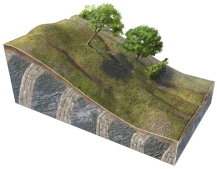A) whether the material involved is rock or is unconsolidated
B) the rate of movement
C) the climate in which the failure occurs
D) the mechanism by which material moves
Correct Answer

verified
Correct Answer
verified
Multiple Choice
All other factors being equal, a slope facing away from the Sun will tend to have
A) faster soil formation than the slope in direct sunlight, primarily because chemical weathering processes will be accelerated.
B) faster soil formation than the slope in direct sunlight, primarily because physical weathering processes will be accelerated.
C) slower soil formation than the slope in direct sunlight, primarily because chemical weathering processes will be slower.
D) slower soil formation than the slope in direct sunlight, primarily because physical weathering processes will be slower.
Correct Answer

verified
Correct Answer
verified
Multiple Choice
Which of the following slope failures moves at the slowest rate?
A) earth flow
B) rock avalanche
C) debris flow
D) rock fall
E) debris avalanche
Correct Answer

verified
Correct Answer
verified
Multiple Choice
Which of the following features is formed by the collapse of caves?
A) travertine
B) stalagmite
C) stalactite
D) sinkhole
E) flowstone
Correct Answer

verified
Correct Answer
verified
Multiple Choice
Which of the following can we use to recognize prehistoric slope failures?
A) sedimentary deposits
B) orientation of beds and other geologic structures
C) masses of rock fragments that are unusual for an area
D) hummocky topography
E) all of these
Correct Answer

verified
Correct Answer
verified
Multiple Choice
Which of the following factors control how minerals weather?
A) the strength of the bonds in minerals
B) what type of mineral is present
C) the temperature at which the original minerals formed
D) whether a mineral typically crystallizes early or late in Bowen's Reaction Series
E) all of these
Correct Answer

verified
Correct Answer
verified
Multiple Choice
Which of the following is a way that slopes fail?
A) large blocks fall from cliffs
B) rocks, soil, sediment, and ice slides down steep hillsides
C) pieces of loose rock accumulate on talus slopes until the angle becomes too steep
D) soil and other loose material can flow rapidly down slopes, forming debris flows
E) all of these
Correct Answer

verified
Correct Answer
verified
Multiple Choice
What type of slope failure is shown in this figure? 
A) rotational slide
B) creep
C) earth flow
D) debris flow
E) rock slide
Correct Answer

verified
Correct Answer
verified
Multiple Choice
Which of the following is the best indication that limestone caves could be present at depth?
A) springs
B) cliffs and overhangs along rivers
C) large quartz crystals laying on the surface
D) gently sloping hills
E) limestone pillars and sinkholes
Correct Answer

verified
Correct Answer
verified
Multiple Choice
Which of the following slope failures is least likely to cause casualties?
A) rock avalanche
B) debris flow
C) creep
D) rock slide
E) rock fall
Correct Answer

verified
Correct Answer
verified
Multiple Choice
Which of the following does NOT physically loosen rocks on the surface?
A) water contracting as it freezes
B) crystals of salt and other minerals that exert an outward force on fractures
C) roots that pry apart fractures as the root grows in size
D) joints that form when rock pressures are released
E) rodents and other burrowing organisms
Correct Answer

verified
Correct Answer
verified
Multiple Choice
What is a common rock that can be dissolved by water and weak acids?
A) quartzite
B) quartz-rich sandstone
C) limestone
D) all of these
Correct Answer

verified
Correct Answer
verified
Showing 81 - 92 of 92
Related Exams